Sixtieth Annual
Sapporo Snow Festival
February 5 - 11, 2009
Background
This week on the island of Hokkaido, upwards of two million people will visit the city of Sapporo as it celebrates its sixtieth annual snow festival with a week of art and festivities. According to The Daily Telegraph, the tradition of crafting elaborate snow and ice sculptures goes back to the early post-war period, when six youths carved six snowmen on the grounds of downtown Odori Park. Since then, the event has become increasingly popular, with overflow from the main event collecting at two additional sites, Tsudome and Susukino. Moreover, the original six humble snowmen have evolved into stunning, world-class masterpieces of sculpture. This year alone, approximately 270 sculptures of varying sizes will be on display.
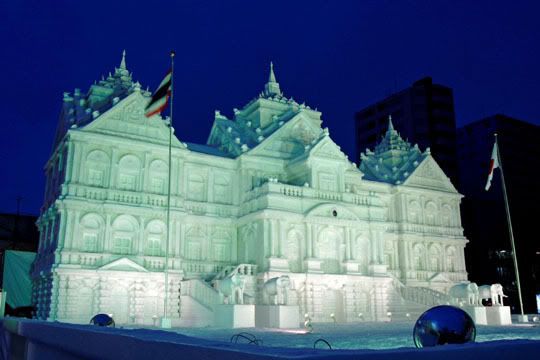
Example of a 2006 sculpture, from The Japan Times Online.
Monuments and Spectacle
Though monumental buildings are a favorite subject for artists, visitors to the festival will also see snowmen carved in the image of popular characters from anime and manga, explore labyrinths hacked out of the ice, and sled, slide, and slush down snowy lanes. At nightfall, the most impressive designs are cunningly illuminated, often appearing to be lit from within. At these times, Odori Park glitters with a rainbow of colors. Often, they are the backdrop for concerts.
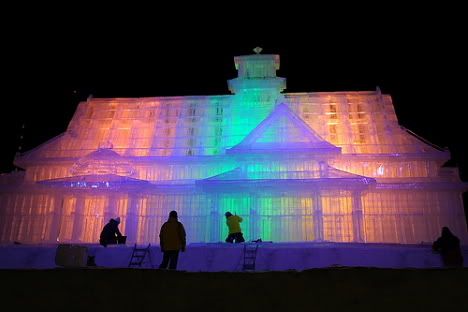
More images at PinkTentacle.com
The following videoclip highlights examples of sculpture and public activities at the festival.

Winter and Wabi Sabi
Like the annual viewing of the cherry blossoms, the Hanami, Sapporo's Snow Festival appeals to the Japanese sense of wabi sabi, an aesthetic quality that derives pleasure from the rhythms of the natural world. Snow is an excellent medium for expressing wabi sabi. It proves that beauty can be found even in the depths of winter. It is imperfect, with each tiny snowflake being unique. It is incomplete, for however monumental the artwork, there is always room for more. Most of all, snow is impermanent. However cold the winter, the snows melt and yield place to the cherry blossoms of spring. Today's snow giant is tomorrow's slush puddle. But while it lasts, the festival offers Japanese a chance to slow down and take pleasure in the season.
Construction
If you can build a sandcastle, you can carve a snow monument. The process is remarkably similar. To begin, a square or rectangular wooden fence is built around the site. The hollow interior is then filled with literally tons of snow, which is carefully compacted for extra firmness, then allowed to harden in the cold until it forms a single block. Scaffolding is constructed around the perimeter of the retaining walls, which are then carefully removed. Working mostly with hand tools, such as shovels, chisels, hatchets, and scrapers, an army of craftspeople begins the task of carving out their design. Due to the lower temperatures, and consequently greater hardness of the snow, much of the work is done at night. Yet however magnificent a particular design is, it is never repeated.
Sculptors
The Japanese government takes an active role in supporting the festival. Many sculptures are government-sponsored, with the work being done by members of Japan's Self Defense Force. Since 1955, Japanese soldiers have designed and carved the largest free-standing exhibits.

Here, soldiers put the finishing touches to The Magic Kingdom,
carved to celebrate the twenty-fifth anniversary of Tokyo Disneyland.
From AsiaOne Travel. Follow the link for more pictures.
The centerpiece of this year's festival, a scale model of the 14th century Nandaemun Gate, was constructed entirely by Self Defense Force personnel. The gate, which once stood in Seoul, South Korea, was partially destroyed last year by an arsonist. Standing at four-fifths the size of the original, the model towers above the crowds in Odori Park. It was commissioned as a gesture of goodwill toward the people of Korea.
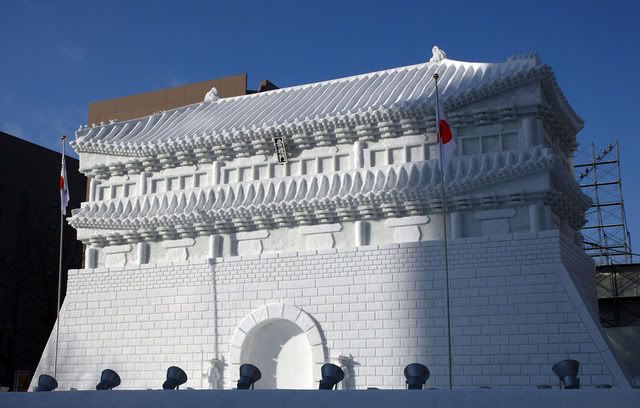
A Japanese news bulletin about the Gate may be read here.
Realism and Surrealism
Using a medium flexible enough to press the limits of self-expression in strange new directions, artists are unafraid to tackle surrealism with both hands. The following images, taken at the Susukino venue, represent the aquariums of local fish markets, including real, frozen fish.
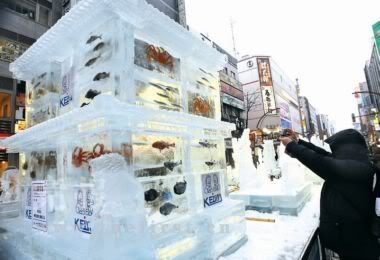
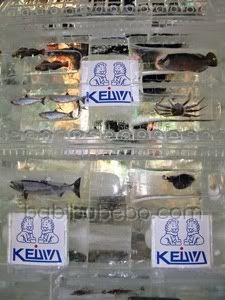
Ocean and sealife themes dominate outside Susukino subway station.
Left, from TheFirst.cn. Right, close-up from Japan Photo Guide.
International Participation
Naturally, the finest artists from all over Japan gather to showcase their talent. Yet foreigners also attend. In this year's thirty-sixth annual International Snow Sculpture Contest, the winning entry was crafted by a team from Thailand, with the runner-ups coming from Lithuania. Details of the contest and photos of all entries may be found at the festival's official site.
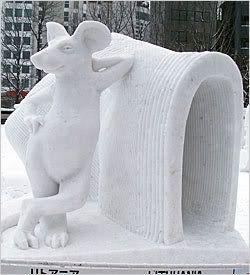
Second Place. "Glove." Lithuanian.
Competition is fierce, and the rules of the contest are rigidly prescribed. No more than twenty international teams are allowed to submit entries. Japanese citizens are strictly forbidden to provide assistance to these artists. A standardized block of snow 3M (H) x 3M (W) x 3M (D) is provided by the festival's organizers. The three-member teams are also provided with a variety of tools. Additional equipment, though not forbidden, is the responsibilty of the sculptors. Four, twelve-hour workdays are set aside before judging begins on February 8. The sculpture must be free-standing, as "placement of supports inside the snow block provided by the committee will not be allowed." Complete contest rules are available from SnowFes.com.
The following videoclip documents sculptors at work.

Links
The Asahi Herald.com
AsiaOne Travel
The Daily Telegraph
TheFirst.cn
Japan Photo Guide
The Japan Times Online
PinkTentacle.com
SnowFes.com
Travelazine.com
Wikipedia
Page Created 7 February 2009.
Last Updated 12 February 2009.
Comments (0)
You don't have permission to comment on this page.